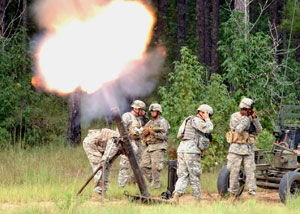Mortar
In a military context, a mortar is an indirect fire weapon, often muzzle-loader, firing shells using a gunpowder propellant. Mortars are short-barreled, having barrels with a length 10 or less times the caliber, or muzzle diameter.
The short barrel is optimized to fire at a higher angle than a howitzer, which has the disadvantage of shorter range, but the advantage of being able to fire over obstacles. The high trajectory lets it be fired from a much smaller area then howitzers or direct fire weapons, so it can be fired through a small opening in the roof of an armored vehicle, or from a dugout.
Light mortars, with a caliber of roughly 50-90mm, are easily carried by well-conditioned troops, and give the infantry commander an indirect fire capability, of longer range than most infantry weapons, under his immediate control. Medium mortars range from the 81-82mm, which still can be carried although in several pieces, to 107 and 120mm that need to be transported in a vehicle.
Heavier mortars are less common, but some militaries, such as the former Soviet bloc, find them quite useful. Such mortars are usually towed by a vehicle, but can be moved much more quickly than an artillery piece.
Several countries have medium mortars capable of automatic fire. Precision guided munitions in the form of guided medium mortar shells are entering combat use.
Mortars are most often smooth-bore, with fin-stabilized shells, and are quite simple mechanically. They tend to be mounted on a bipod and metal base plate on the ground. All these features make them far simpler to construct than cannon. Simple light and even medium mortars can be improvised, either as single-shot weapons, or for use in guerilla warfare when the guerillas have little outside support.
The most common filler for the warhead of a mortar shell is high explosive, which does damage by blast and fragmentation. Illuminating shells work well with the high trajectory of a mortar; when fired at night, they burn overhead and light the area. White phosphorus is another load used to create smoke or start fires.
